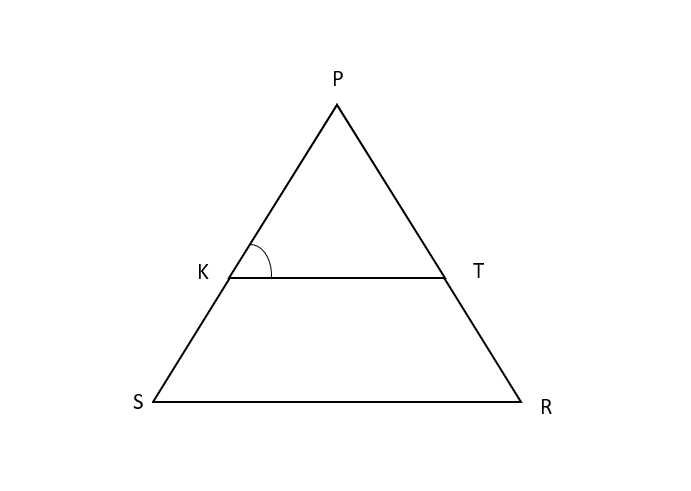
In the given figure, $\dfrac{{PK}}{{KS}} = \dfrac{{PT}}{{TR}}$ and $\angle PKT = \angle PRS$. Prove that $\Delta PSR$ is an isosceles triangle.


Answer
609.3k+ views
Hint: Try to solve using SAS congruence postulate.
Given: $\dfrac{{PK}}{{KS}} = \dfrac{{PT}}{{TR}}$ and $\angle PKT = \angle PRS$
To prove that $\Delta PSR$ is an isosceles triangle.
An isosceles triangle is a triangle with (at least) two equal sides.
Proof:
$\dfrac{{PK}}{{KS}} = \dfrac{{PT}}{{TR}}\left( {\because {\text{Given}}} \right)$
Rewriting above as:
$\dfrac{{KS}}{{KP}} = \dfrac{{RT}}{{PT}}$
Adding 1 both sides, we get
$
\Rightarrow \dfrac{{KS}}{{KP}} + 1 = \dfrac{{RT}}{{PT}} + 1 \\
\Rightarrow \dfrac{{KS + KP}}{{KP}} = \dfrac{{RT + PT}}{{PT}} \\
$
Now, from the figure, we can say that \[KS + KP = PS\] and \[RT + PT = PR\].
$\therefore \dfrac{{PS}}{{KP}} = \dfrac{{PR}}{{PT}}$
Now, $\angle KPT$ is common angle to $\Delta KPT$ and $\Delta SPR$
SAS congruence postulate states that if two sides and the included angle of one triangle are congruent to two sides and the included angle of another triangle, then these two triangles are congruent and vice versa.
Using SAS similarity of triangles, $\Delta KPT \sim \Delta SPR$
$
\Rightarrow \angle PKT = \angle PSR \\
\Rightarrow \angle PRS = \angle PSR{\text{ }}\left( {\because \angle PKT = \angle PRS} \right) \\
$
Since, two angles of $\Delta PSR$are equal, it is an isosceles triangle.
Hence Proved.
Note: Whenever you need to prove sides as equal of a triangle, always try to prove triangles as similar. Also, we have the methods SSS (side-side-side), SAS (side-angle-side), ASA (angle-side-angle), AAS (angle-angle-side) and AAA (angle-angle-angle), to prove that two triangles are similar.
Given: $\dfrac{{PK}}{{KS}} = \dfrac{{PT}}{{TR}}$ and $\angle PKT = \angle PRS$
To prove that $\Delta PSR$ is an isosceles triangle.
An isosceles triangle is a triangle with (at least) two equal sides.
Proof:
$\dfrac{{PK}}{{KS}} = \dfrac{{PT}}{{TR}}\left( {\because {\text{Given}}} \right)$
Rewriting above as:
$\dfrac{{KS}}{{KP}} = \dfrac{{RT}}{{PT}}$
Adding 1 both sides, we get
$
\Rightarrow \dfrac{{KS}}{{KP}} + 1 = \dfrac{{RT}}{{PT}} + 1 \\
\Rightarrow \dfrac{{KS + KP}}{{KP}} = \dfrac{{RT + PT}}{{PT}} \\
$
Now, from the figure, we can say that \[KS + KP = PS\] and \[RT + PT = PR\].
$\therefore \dfrac{{PS}}{{KP}} = \dfrac{{PR}}{{PT}}$
Now, $\angle KPT$ is common angle to $\Delta KPT$ and $\Delta SPR$
SAS congruence postulate states that if two sides and the included angle of one triangle are congruent to two sides and the included angle of another triangle, then these two triangles are congruent and vice versa.
Using SAS similarity of triangles, $\Delta KPT \sim \Delta SPR$
$
\Rightarrow \angle PKT = \angle PSR \\
\Rightarrow \angle PRS = \angle PSR{\text{ }}\left( {\because \angle PKT = \angle PRS} \right) \\
$
Since, two angles of $\Delta PSR$are equal, it is an isosceles triangle.
Hence Proved.
Note: Whenever you need to prove sides as equal of a triangle, always try to prove triangles as similar. Also, we have the methods SSS (side-side-side), SAS (side-angle-side), ASA (angle-side-angle), AAS (angle-angle-side) and AAA (angle-angle-angle), to prove that two triangles are similar.
Recently Updated Pages
Master Class 7 Maths: Engaging Questions & Answers for Success

Class 7 Question and Answer - Your Ultimate Solutions Guide

Master Class 12 Economics: Engaging Questions & Answers for Success

Master Class 12 Maths: Engaging Questions & Answers for Success

Master Class 12 Biology: Engaging Questions & Answers for Success

Master Class 12 Physics: Engaging Questions & Answers for Success

Trending doubts
Full Form of IASDMIPSIFSIRSPOLICE class 7 social science CBSE

Convert 200 Million dollars in rupees class 7 maths CBSE

What are the controls affecting the climate of Ind class 7 social science CBSE

Write a letter to the editor of the national daily class 7 english CBSE

Fill in the blanks with appropriate modals a Drivers class 7 english CBSE

Repeated addition of the same number is called a addition class 7 maths CBSE





